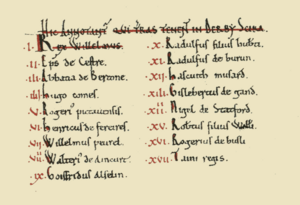Derbyshire Domesday Book tenants-in-chief facts for kids
The Domesday Book was a huge survey ordered by William the Conqueror in 1086 AD. It was like a giant census and property record for England. It helped King William understand who owned what land and how much tax they should pay after the Norman Conquest of England in 1066.
This book lists the most important landowners in Derbyscire (which is now Derbyshire). These people were called tenants-in-chief. They held their land directly from the King.
Contents
Who Owned Land in Derbyshire?
The Domesday Book lists many important people and groups who owned land in Derbyshire. These were the main tenants-in-chief:
- King William: He was the first Norman King of England. He became king after winning the Battle of Hastings in 1066. He also ruled Normandy as a Duke. As the King, he owned a lot of land himself.
- Bishop of Chester: This was a high-ranking church leader. Churches and religious groups often owned large amounts of land during this time.
- Abbey of Burton: An abbey is a type of monastery. Like the Bishop, this religious institution owned land.
- Earl Hugh of Chester: He was a powerful noble who helped William the Conqueror invade England. He brought many ships to the invasion.
- Roger de Poitou: His father, Roger de Montgomery, was one of King William's main advisors.
- Henry de Ferrers: He worked for King William and his son, King William II, in important government jobs.
- William Peverel: King William gave him over a hundred manors (large estates with villages and farms) in central England. This land became known as the Honour of Peverel. He also built Peveril Castle in Derbyshire.
- Walter D'Aincourt: He was related to King William through marriage. He received over 70 manors in the East Midlands and Yorkshire.
- Geoffrey Alselin
- Ralph son of Hubert (FitzHubert): He was the son of Hubert de Corcun.
- Ralph de Buron
- Hascoit Musard de Bretagne: He fought in King William's army at the Battle of Hastings. He was given 25 manors in six different English counties. His family's main home was in Staveley, Derbyshire.
- Gilbert de Gant (Ghent): He was related to King William's wife.
- Nigel de Stafford: He was the son of Robert de Stafford.
- Robert Curthose: He was King William the Conqueror's son. He became the Duke of Normandy after his father died in 1087.
- Roger de Busli: He received many manors in Nottinghamshire, Yorkshire, and other counties like Derbyshire. These lands later became known as the Honour of Blyth.
- King's Thanes: These were local English nobles who held land directly from the King before the Norman Conquest. Some of them were allowed to keep their lands after the conquest.
Other Landowners
Besides the main tenants-in-chief, the Domesday Book also mentions other people who owned land in specific places in Derbyshire. These included:
- Dunning and Stenulf of Sutton
- Edmund
- Ernwy of Stanton
- Healfdene of Cromwell
- Leofwin of Aston
- Osmund Benz
- Toli of Sandiacre
How Derbyshire Was Divided
In the Domesday Book, Derbyshire was split into different areas called wapentakes. These were like smaller districts or divisions of the county. The six wapentakes were Apultre, Hamestan, Littlechirch, Morlestan, Scarvedale, and Walecross. There was also a special area called Peche-fers, which is now known as the Peak Forest.
Lands Held by Tenants-in-Chief
The Domesday Book carefully listed all the lands each tenant-in-chief held. This table shows some of the main landowners and the many places they controlled in Derbyshire.
| Tenant-in-Chief | Lands |
|---|---|
| King William | The King owned a vast amount of land across Derbyshire, including important towns and many villages. |
| Bishop of Chester (St John) | Held lands in areas like Bupton, Draycott, and Sawley. |
| Abbey of Burton (St Mary & St Modwen) | Controlled lands in places such as Appleby Magna, Caldwell, and Hilton. |
| Earl Hugh of Chester | Owned lands including Allestree, Kniveton, and Mackworth. |
| Roger de Poitou | Held lands in Beighton, Hardstoft, and Sutton Scarsdale. |
| Henry de Ferrers | A very powerful landowner with many manors, including Alkmonton, Duffield, and Hartington. |
| William Peverel | His lands included Bolsover, Castleton, and Heanor. |
| Walter D'Aincourt | Owned lands in Elmton, Holmesfield, and Morton. |
| Geoffrey Alselin | Held lands in Alvaston, Breaston, and Elvaston. |
| Ralph son of Hubert (FitzHubert) | Controlled lands in Ashover, Crich, and Hathersage. |
| Ralph de Buron | His lands included Denby, Horsley, and Weston Underwood. |
| Hascoit Musard de Bretagne | Held lands in Great Barlow, Staveley, and Wadshelf. |
| Gilbert de Gant (Ghent) | Owned lands in Breaston, Ilkeston, and Shipley. |
| Nigel de Stafford | Controlled lands in Donisthorpe, Foremark, and Smisby. |
| Robert Curthose | Held the land of Stanley. |
| Roger de Busli | His lands included Alfreton, Dore, and Risley. |
See also



